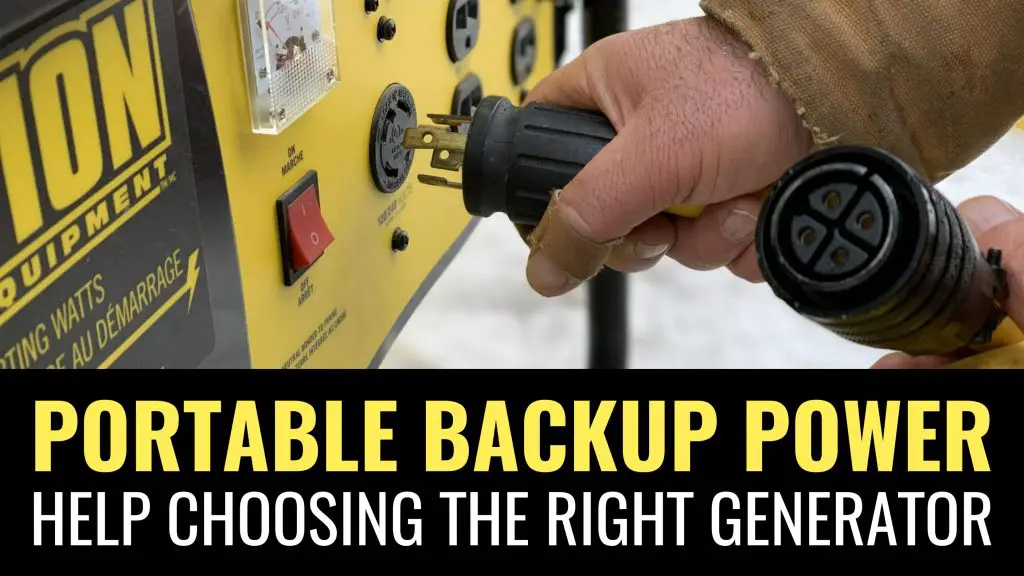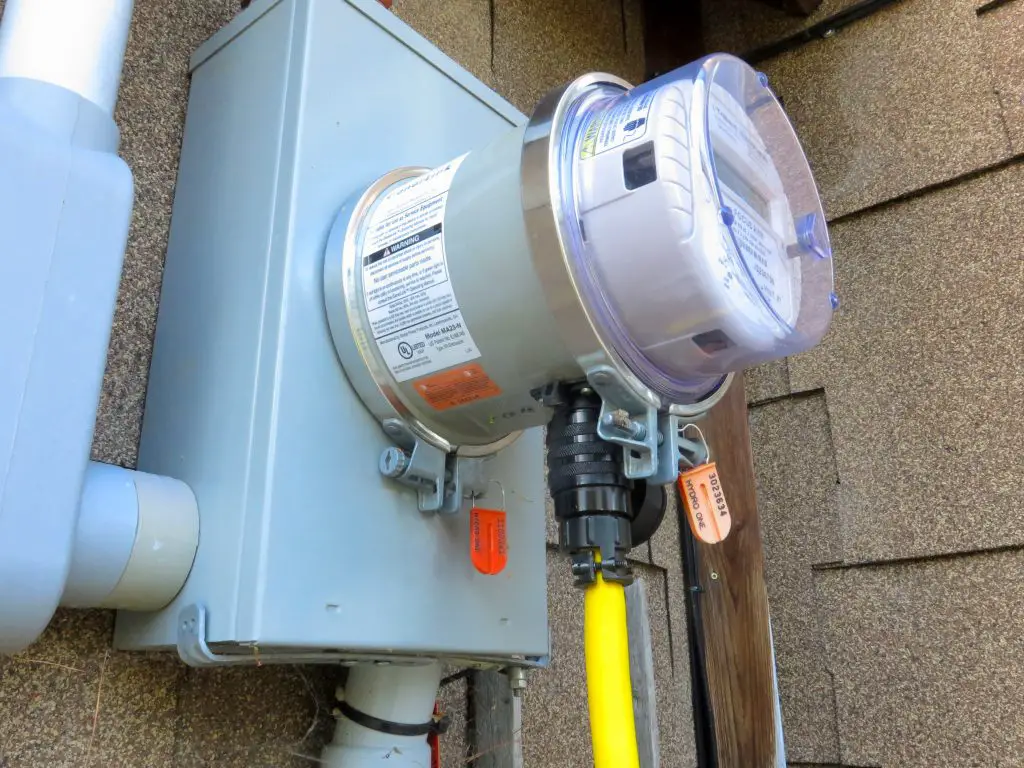Thinking of buying a generator? Don’t do it before reading this article and watching the video. Everything you need to know about connecting a generator to your house is here, plus lots of insights on generator selection, and a FAQ section at the end. Click on any of the Table of Contents items on the left to go directly to that section.
- Reading Time = 13 minutes
- VideoWatch Time = 10 1/2 minutes
Declining cost of gas generators, and greater concern about the lack of grid power reliability are the two main reasons more people than ever are interested in buying a portable generator. Fuel efficiency, inverter models, eco mode, electric start, starting watts, run time, powering sensitive electronics – these are all options now, and it can take a bit of work to understand how safety features work. As you’ll see, this is true for everything from powering items on a camping trip or your entire house.

The thing is, most people only know that they want this sort of protection, not how backup power works nor how to choose equipment wisely. This is especially true when it comes to one of the most popular backup options – the large portable generator, and especially dual fuel and tri fuel models. This new breed of multi-fuel generators are enormously more flexible and better suited to long-term outages, as you’ll see.
Why Big Gas Generators Are Popular

Gas generators come as small, big, quiet, not-so-quiet and permanently installed versions. And of all these choices, large generators are the one category that’s consistently popular with homeowners and small business owners. Defined as putting out 8000 watts of power or more, large portables deliver plenty of juice and they can be used for more than just electrical backup.
You can use a generator at the lake or for building projects beyond the grid, or when the grid goes down. Value is perhaps the most attractive feature for these models. Large portables deliver the most electrical power output for a given price and have become very economical in recent years. See “Generator Costs Then & Now” you’ll be surprised by the numbers.
It’s one thing to own a generator, but another thing to legally connect that generator to items in a building. Electrical authorities everywhere forbid direct connection of a generator to an electrical panel unless that system is physically prevented from back feeding generator power into the grid.
The issue is line worker safety and the threat posed if power accidentally comes back into the main service lines, from a generator connected to the supposedly “dead” side of the power grid. Laws are in place to protect workers from this potentially dangerous connection and it means there are only a few options for legally making emergency generator connections in homes and businesses.
Generator Option#1: Extension Cord Connection

Today’s multi-outlet generator extension cords mean this option isn’t as troublesome as it used to be because only one extension cord needs to come indoors. That said, extension cords still leave a lot to be desired. They’re what most people end up using unless they’re taught about generator connection alternatives, and it’s worth learning about more convenient than cords.
Besides the hassle of connecting items with multiple extension cords, it’s almost impossible to make full use of the power of a large portable using extension cords only. There are only so many things you can plug into cords.
Generator Option#2: Meter Base Connection

Imagine an extended, cylindrical meter base with a port for accepting a proprietary cable that connects to a generator. That’s what you see above and it’s a meter base generator connection system works. It’s the simplest to install in an existing building without doing extensive electrical work.
Generlink is the best example of meter base generator connection hardware right now. When power goes out, plug one end of the connection cable into the meter base and the other end into the generator. Fire up the engine and that’s it. The Generlink automatically disconnects generator power from the grid, while also allowing generator power to flow into the main electrical panel and to various circuits. Besides connecting and firing up the generator, part of the meter base connection regime happens down at your electrical panel.
You’ll need to switch off the breaker serving high-load, non-essentials such as the electric water heater, baseboard heaters or clothes dryer. The Generlink keeps on delivering generator power to the house as long as the generator is running and even after grid power is restored. The generator needs to be shut off for grid power to switch back ON. There are only two drawbacks with the Generlink. It’s a fairly expensive unit ($1100 to $1500 in Canada with cable depending on the model), and not all jurisdictions allow Generlinks to be installed. Check locally to find out. I have a Generlink at my house and it has powered my place beautifully for years during an outage.
Generator Option#3: Manual Transfer Switch

The best time to install one of these is when major electrical work is already being done to the main service on a building. Transfer switches provide an opportunity to connect a generator cable to your electrical system, and connect either the generator or the grid to the building circuits, but not both at the same time.
Transfer switches typically work with a small, secondary panel. Essential circuits are connected to this panel during installation, and this panel is the only one that gets energized when the manual switch is flipped during and outage. The connection between the grid and panel is also cut when the transfer switch is moved to generator mode, then re-established when the switch is pushed back to grid mode.
TECH TIP: Inverter Generators are Unique

Inverter generators are a special breed and they’re easy to like. The create clean power that never damages sensitive electronics. When you demand less electricity, engine speed on an inverter slows down to match (reducing noise ever further and reducing fuel consumption), and the purity of electricity produced will never harm sensitive electronics.
Portable Generators: Wiring for “Plan B”
You can create a simple system for allowing a portable generator to power a home or business, but that doesn’t mean the system will keep on working when it’s needed. This is why it makes sense for you to choose and install essential equipment so it can accept power from any small portable generator that can’t use a hard-wired interface.
Typical water well pumps, for instance, use 240 volts but this means the pump can’t be powered by a small 120 volt-only generator if that becomes necessary. Better to install a 120 volt pump that’s also wired with a plug end and not hard-wired into the building.
Same goes for essential heating and ventilation equipment. The ability to revert back to powering essential items with any generator using extension cords is a worthwhile “plan B” in case the large generator or power connection system you have fails.
Dual Fuel Models and More
Champion is at the leading of dual fuel and tri fuel generators, and they’re particularly good at keeping the lights on during extended power outages. That’s because these models can run on gasoline, propane or natural gas. The video below is a tour of a dual fuel and tri fuel model, and why they’re worth a look if you’re interested in preparing for an outage that lasts more than a few days.
Portable Generator Costs Then & Now

I bought my first gas generator in 1988, and it costs $6700 in today’s money ($3500 at the time), for a nice, red 3500 watt model that was one of the best Honda generators available at the time. That’s the old timer you see above, on the cart I built because generators never came with wheels back them. Nothing fancy by today’s standards, just a good, brand-name portable with no wheels. Fast-forward 35 years and you can buy generators that are much larger and for a lot less money. Are they any good? Some are great and some are junk. It all depends on the brand you choose.
In my own field trials over the last number of years, I’ve found Champion generators to be the best in their class in performance and price by far. You can get a 12,000 watt portable Champion for about $2000. That’s almost 3 1/2x more power at less than 30% of the cost of that first generator I bought. The yellow guys also have the best parts and service program I’ve seen from any brand. They’ve got technicians standing by to give detailed phone and video guidance on how to fix things yourself if you’re so inclined. Low price and good performance are the big reasons generators are becoming almost as popular these days as lawnmowers.
Care & Feeding of Portable Generators
There are a few things you need to do to keep your generator working well, and most importantly, ready to start when you need the thing.
Rotate stored gasoline: Burn stored gas in a vehicle after six months. Gasoline bought in winter starts engines more easily in cold weather than gas bought in summer.
Preserve gas in the tank: A portable generator can sit for months without running. Add gas preservative to the tank, then let the preserved gas work through the running engine for a while before storage. Faster starting is what this delivers.
Change oil often: Generators need fresh oil after every 50 to 100 hours of operation. Warn property owners that they need to have motor oil stored as well as fuel for long-term outages.
Protect from the weather: Generators aren’t supposed to be exposed to wet or snowy weather, but that’s usually the kind of weather they’re needed in. There are generator covers made specifically to protect generators and help them last longer. They fit properly and are easy to store with the generator so they are ready to use when needed. An open carport (never a garage) or open verandah on a workshop can also shelter the unit from nasty weather.
Portable Generator FAQs
Q: What size portable gas generator will power a house?
A: This varies a lot depending on your expectations. The smallest portable generator I’ve found practical for a house is 3500 watts, but this is bare bones. It will power lights, a fridge, freezer, and water well pump, but not all at once. If you want to run a coffee maker, for instance, you’ll need to wait until the fridge stops running. For more complete powering of a house, 8000 to 9000 watts is getting there. For powering an entire modern house without leaving anything out, most people need a 20,000 stationary backup generator.
++++++++
Q: What’s the best portable generator to buy?
A: This depends on your application, your budget, and whether you want a standard gas generator or one of the inverter models or a dual fuel design. For years Honda generators were by-far the best and I’ve owned three over the years. These days other brands have more than caught up with Honda and surpassed this company in design and value for the dollar. The best combination of price, reliability, first pull starting and features that I’ve seen so far is Champion.
++++++++
Q: What can a 2200 watt generator run?
A: The best way to begin answering this is to add up the wattage of things you’d like to power. Online calculators exist to help with this, but you need to keep something in mind. Any item with a motor will require 2x to 3x more power for the second or two after starting. This is called starting watts and any generator you choose must be able to deliver what’s needed. In practice, 2200 watt generators are quite small, so they’re meant for powering lights, on a camping trip, or with power tools.
++++++++
Q: Which is the best small generator?
A: There is no such thing as a “best” in such a wide category. I own a tiny 1000 watt Honda inverter generator and it’s a beautiful model that’s light and super-portable. But something like this is too small for many things.
++++++++
Q: How long does a small gas generator last?
A: This question can mean different things. Do you mean how long the best generators last before wearing out? Many years. With frequent oil changes you can expect decades of life. The portable generator I bought 35+ years ago is still going strong. How long can a small gas generator last on a single tank of gasoline? In other words, what’s the run time? This depends mostly how much electricity you use, how fuel efficient the model is, whether or not your generator has eco mode or if it’s one of the inverter models. Most of the best portable generators have a run time of 5 to 8 hours on a single tank of fuel.
++++++++
Q: Who makes the best gas powered generators?
A: For years I would have told you Honda generators were the best. People used to say that if you couldn’t afford a commercial-duty diesel generator, then get They still make great stuff, but other generator companies are pulling ahead in features, dual fuel capabilities, price of the generator, special features, etc.
++++++++
Q: What are the disadvantages of a gas generator?
A: Noise, the need for fuel, and the need for oil changes are the three biggest disadvantages to a gas generators. Inverter models are quieter and use less fuel than comparable generator. Fuel efficiency
++++++++
Q: What can you run on a small generator?
A: Any collect of items up to the rating of the generator as advertised can be powered. Visit one of the generator selection tools online for help figuring out what you need. The best of these tools allow for the 2x or 3x higher power requirements need for items with electric motors. These draw more starting watts then they do when running.
+++++++++
Q: How long can you continuously run a small generator?
A: If you mean how long between fuel fill-ups, that depends on tank capacity, the fuel efficiency of your until, and how much electricity you demand. The more power you ask for, the harder the engine has to work, the more fuel consumed. Five to 8 hours is a typical run time between fuel fill up. Whatever you do, don’t gas-up a running generator. Shut it down, let it cool for five minutes, then gas up, check the oil, and start the engine again.
++++++++
Q: What is the best portable whole house generator?
A: A handful of companies make whole house generators, and these provide the easiet option for backup protection for power outages. Generac is a popular brand and Champion makes some excellent whole house models too, some with special load-sharing electrical panels that allow more household items to be powered from a given size of whole house generator.
++++++++
Q: How long can you run a portable gas generator continuously?
A: If you mean on one tank of gasoline, that’s typically five to eight hours. But if you have a dual fuel or tri fuel model connected to a large propane or natural gas supply, the answer is “almost continously”. The only reason to shut down one of these dual fuel generators is to change engine out, about once every 100 hours of operation
++++++++
Q: Is it cheaper to run a generator on propane or gas?
A: The cheapest option is natural gas, then gasoline, then propane from a large tank. The most expensive option is running dual fuel generators to create electrical power from a 20 lbs. or 30lbs. propane tank. Expensive, but sometimes handy in a pinch.
++++++++
Q: How much does a small generator cost?
A: Small generators can cost a wide range of prices depending on size, features and quality. You can get a 950 watt economy model for about $300. 2200 watt high-end inverter generators will cost $1500 and they deliver very quiet performance, clean power, and the most economical fuel consumption possible. This is especially true when operated in eco mode.
++++++++
Q: Are portable generators worth it?
A: Portable generators are very worthwhile for a range of people. Anyone who needs power away from the grid, or homeowners who want an inexpensive way to get backup electricity during a power outage are the most common users of portable generators.
 I hope you found this generator guide useful. Please consider helping me cover the cost of creating and publishing content like this. Click the “buy me a coffee” button below for a safe, simple and fast way to make a contribution. Thanks for partnering with me to keep this website up and running. Thank you!
I hope you found this generator guide useful. Please consider helping me cover the cost of creating and publishing content like this. Click the “buy me a coffee” button below for a safe, simple and fast way to make a contribution. Thanks for partnering with me to keep this website up and running. Thank you!
– Steve Maxwell



